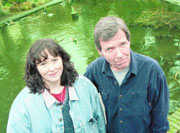THE FOLLOWING may not surprise anyone who’s ever sat for an hour in traffic waiting to enter westbound lanes on state Route 520 in Bellevue: Your afternoon commute from the Eastside to Seattle is likely to be slower than that of the suburbanites on the other side of the median returning to the Eastside. Say what? The traditional rule of commuting says the heaviest traffic should be flowing out of the city in the afternoon, not in.
But data compiled recently by the Washington State Transportation Center (TRAC) affirms that a trend developing for years on the 520 bridge has finally grown into full-blown “reverse congestion.” Mark Hallenbeck, director of TRAC’s office at the University of Washington—it has researchers at the UW and Washington State University—says traffic buildup on 520 starts earlier and lasts longer in the westbound lanes during the afternoon rush hour than it does in the eastbound lanes. Hallenbeck says this doesn’t necessarily mean that more people are traveling from the Eastside to Seattle; he notes that commuting patterns on I-90 remain conventional. Eastside cities have been touting themselves as the new economic hub of the Puget Sound region, but Hallenbeck says reverse congestion on 520 has more to do with job sprawl than with job growth. Whereas public transportation can readily serve the more tightly clustered employment districts in Seattle, Hallenbeck says, Metro is having a lot more difficulty routing buses to the far-flung suburban campuses of Microsoft, Molecumetics, and Costco. Employees there are forced to either drive or pack their hiking boots, he says.
TRAC’s findings could affect the operation of the reversible lanes on I-90. The state Department of Transportation is considering whether those lanes should carry traffic in both directions during rush hour. Baseball fans have been grousing that the current system, which opens the lanes to eastbound traffic in the afternoons, works contrary to traffic going to Safeco Field.
Ned Conroy of the Puget Sound Regional Council wishes the findings would lead to reconsideration of weightier matters, such as land-use planning. “In the long run, it’s the only way you’re going to solve the congestion issue—put enough jobs and [houses] on the Eastside so that those commutes won’t be as necessary,” says Conroy.
Kevin Fullerton







